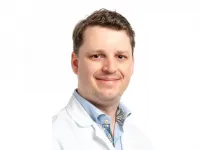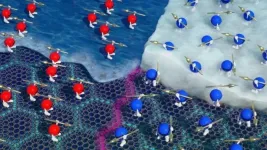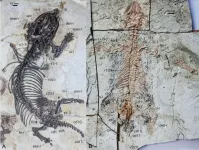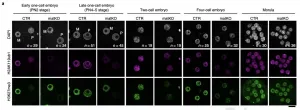Genomes of the earliest Europeans
Ancient genomes shed new light on the earliest Europeans and their relationships with Neandertals
2021-04-07
(Press-News.org) An international research team has sequenced the genomes of the oldest securely dated modern humans in Europe who lived around 45,000 years ago in Bacho Kiro Cave, Bulgaria. By comparing their genomes to the genomes of people who lived later in Europe and in Asia the researchers from the Max Planck Institute for Evolutionary Anthropology in Leipzig, Germany, show that this early human group in Europe contributed genes to later people, particularly present-day East Asians. The researchers also identified large stretches of Neandertal DNA in the genomes of the Bacho Kiro Cave people, showing that they had Neandertal ancestors about five to seven generations back in their family histories. This suggests that mixture with Neandertals was the rule rather than the exception when the first modern humans arrived in Europe.
Last year, a research team led by researchers from the National Institute of Archaeology with Museum at the Bulgarian Academy of Sciences and the Max Planck Institute for Evolutionary Anthropology, Germany, reported the discovery of modern human remains found in direct association with the Initial Upper Palaeolithic stone tools at the site of Bacho Kiro Cave in Bulgaria. The oldest individuals found in the cave were directly radiocarbon dated to between 43,000 and 46,000 years ago. They are thus the earliest known dispersal of modern humans across the mid-latitudes of Eurasia.
Mateja Hajdinjak and colleagues have now sequenced the genomes of five individuals found at the Bacho Kiro Cave. Four individuals are between 43,000 to 46,000-years-old and were found together with stone tools belonging to the Initial Upper Palaeolithic, the earliest culture associated with modern humans in Eurasia. An additional individual found in the cave is around 35,000-years-old and found with stone tools of a later type. It was previously thought that bearers of the Initial Upper Palaeolithic died out without contributing genetically to modern humans arriving later. However, the researchers now show that the oldest Bacho Kiro Cave individuals, or groups closely related to them, contributed genes to present-day people. Surprisingly, this contribution is found particularly in East Asia and the Americas rather than in Europe where the Bacho Kiro Cave people lived. These genetic links to Asia mirror the links seen between the Initial Upper Palaeolithic stone tools and personal ornaments found in Bacho Kiro Cave and tools and ancient jewelry found across Eurasia to Mongolia.
Genetic differences between individuals
Importantly, the later 35,000-year-old individual found in Bacho Kiro Cave belonged to a group that was genetically distinct from the earlier inhabitants of the cave. This shows that the earliest history of modern humans in Europe may have been tumultuous and involved population replacements.
The earliest people at Bacho Kiro Cave lived at a time when Neandertals were still around. The researchers therefore scanned their genomes for fragments of Neandertal DNA. "We found that the Bacho Kiro Cave individuals had higher levels of Neandertal ancestry than nearly all other early humans, with the exception of a 40,000-year-old individual from Romania. Crucially, most of this Neandertal DNA comes in extremely long stretches. This shows that these individuals had Neandertal ancestors some five to seven generations back in their family trees" says Mateja Hajdinjak.
Although only a handful of genomes from modern humans who lived at the same time in Eurasia as some of the last Neandertals have been recovered, nearly all of them have recent Neandertal ancestors. "The results suggest that the first modern humans that arrived in Eurasia mixed frequently with Neandertals. They may even have become absorbed into resident Neandertal populations. Only later on did larger modern human groups arrive and replace the Neandertals" says Svante Pääbo, who coordinated the genetic research.
INFORMATION:
Original publication
Mateja Hajdinjak, Fabrizio Mafessoni, Laurits Skov, Benjamin Vernot, Alexander Hübner, Qiaomei Fu, Elena Essel, Sarah Nagel, Birgit Nickel, Julia Richter, Oana Teodora Moldovan, Silviu Constantin, Elena Endarova, Nikolay Zahariev, Rosen Spasov, Frido Welker, Geoff M. Smith, Virginie Sinet-Mathiot, Lindsey Paskulin, Helen Fewlass, Sahra Talamo, ?eljko Rezek, Svoboda Sirakova, Nikolay Sirakov, Shannon P. McPherron, Tsenka Tsanova, Jean-Jacques Hublin, Benjamin M. Peter, Matthias Meyer, Pontus Skoglund, Janet Kelso and Svante Pääbo
Initial Upper Palaeolithic humans in Europe had recent Neanderthal ancestry.
Nature; 7 April, 2021
[Attachments] See images for this press release:
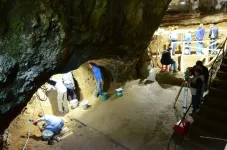
ELSE PRESS RELEASES FROM THIS DATE:
2021-04-07
Working safely is not only about processes, but context - understanding the work environment and circumstances, and being able to predict what other people will do next. A new system empowers robots with this level of context awareness, so they can work side-by-side with humans on assembly lines more efficiently and without unnecessary interruptions.
Instead of being able to only judge distance between itself and its human co-workers, the human-robot collaboration system can identify each worker it works with, as well as the person's skeleton model, which is an abstract of body volume, says Hongyi Liu, a researcher at KTH Royal Institute of Technology. Using this information, the context-aware robot system can recognize ...
2021-04-07
3D-mammography reduces the number of breast cancer cases diagnosed in the period between routine screenings, when compared with traditional mammography, according to a large study from Lund University in Sweden. The results are published in the journal Radiology.
"Our results indicate that 3D-mammography, or digital breast tomosynthesis, possibly detects cancers that would otherwise have been diagnosed later at a more advanced stage", says Kristin Johnson, doctoral student at Lund University and radiology resident at Skåne University Hospital.
A large prospective screening study conducted at Skåne ...
2021-04-07
WESTMINSTER, Colorado - April 07, 2021 - As the number of weed populations resistant to multiple herbicides continues to soar, it is clear that better tools are needed to help growers rapidly diagnose resistance issues. With more timely access to information, they can take earlier, proactive steps to keep resistant weeds from spreading.
A recent article in the journal END ...
2021-04-07
An international team of researchers has studied individual differences in the behaviour of red deer. They found that several observed behaviours form a personality component, which they labelled "Confidence/Aggressiveness".
As is commonly known, individual people behave consistently different from each other and these kinds of consistent differences in behaviour are called personality. Studies on species other than humans, from insects to elephants, have found that personalities are widespread in nature.
The team consists of researchers from the Czech University of Life Sciences Prague, the University of South Bohemia, Czech Republic, the University of Vienna, Austria, and the University of Turku, Finland and is led by Bruno Esattore from the Department of ...
2021-04-07
Cardiovascular diseases are usually complex and affect multiple organs simultaneously. Treatments for vascular diseases in the brain may therefore have implications for the treatment of cardiac diseases. It is therefore important to understand the respective causes and effects. This study explores the causes of intracerebral haemorrhages and links them to the risk of stroke associated with atrial fibrillation. It suggests a fundamental new assessment of the effects of blood thinning on intracerebral haemorrhages.
About 1,000 patients with intracerebral haemorrhage are treated at stroke units each year in Switzerland. Intracerebral haemorrhages are more often fatal than other forms of strokes, ...
2021-04-07
Most materials go from being solids to liquids when they are heated. One rare counter-example is helium-3, which can solidify upon heating. This counterintuitive and exotic effect, known as the Pomeranchuk effect, may now have found its electronic analogue in a material known as magic-angle graphene, says a team of researchers from the Weizmann Institute of Science led by Prof. Shahal Ilani, in collaboration with Prof. Pablo Jarillo-Herrero's group at the Massachusetts Institute of Technology (MIT).
This result, published today in Nature, comes thanks to the first ever measurement of electronic entropy in an atomically-thin two dimensional ...
2021-04-07
For those who live in an area blighted by ticks, the threat of Lyme disease can cast a shadow over the joy of spring and summer. These blood-sucking arachnids can transmit bacteria into the bloodstream of their unsuspecting host, causing the disease. Early treatment is essential, but current tests are not usually sensitive enough to detect the disease in early-stage patients. A recent study in open-access journal END ...
2021-04-07
A joint research team led by Dr. MAO Fangyuan and Dr. ZHANG Chi from the Institute of Vertebrate Paleontology and Paleoanthropology (IVPP) of the Chinese Academy of Sciences and Prof. MENG Jin from the American Museum of Natural History have discovered two new species of mammal-like, burrowing animals that lived about 120 million years ago in what is now northeastern China.
The new species, described in Nature on April 7, are distantly related. However, they independently evolved traits to support their digging lifestyle. They represent the first "scratch diggers" discovered in this ecosystem.
"There are many hypotheses about why animals dig into the soil and live underground," said Prof. MENG, lead author of the study. "For protection against predators, ...
2021-04-07
A recent study finds that unhealthy eating behaviors at night can make people less helpful and more withdrawn the next day at work.
"For the first time, we have shown that healthy eating immediately affects our workplace behaviors and performance," says Seonghee "Sophia" Cho, corresponding author of the study and an assistant professor of psychology at North Carolina State University. "It is relatively well established that other health-related behaviors, such as sleep and exercise, affect our work. But nobody had looked at the short-term effects of unhealthy eating."
Fundamentally, the researchers had two questions: Does unhealthy eating behavior affect you at work the next day? And, if so, why?
For the study, ...
2021-04-07
An epigenetic study at the RIKEN Center for Integrative Medical Sciences shows that in mouse egg cells, modifications to histone H2A at lysine 119 lay the groundwork for inherited DNA functional modifications from the mother.
In books and the movies, a group of people on a special mission always sends out a scout to do reconnaissance before they proceed. Sometimes, the scouts leave signs or markers that allow the group to know where there should go. Researchers led by Azusa Inoue at the RIKEN Center for Integrative Medical Sciences in Japan have discovered a mark left behind in unfertilized egg cells that determine which DNA modifications ...
LAST 30 PRESS RELEASES:
[Press-News.org] Genomes of the earliest Europeans
Ancient genomes shed new light on the earliest Europeans and their relationships with Neandertals


